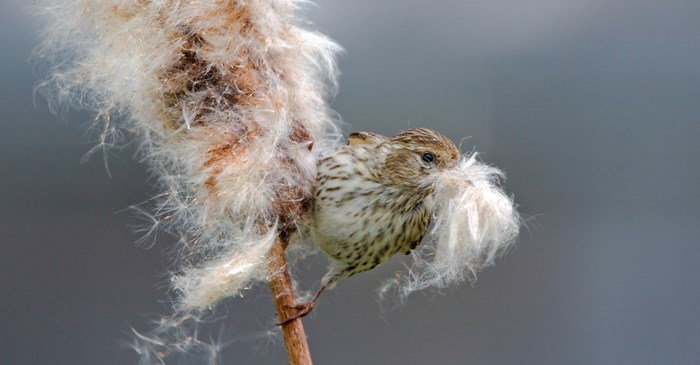As daylight hours and warmth increase this spring, birds begin preparing their nesting sites. Help them “feather their nests” by identifying locations in your yard where you can help their growing families stay safe and where they can easily find food.
Layer your yard with nesting plants
Native trees and shrubs are the best sources for cover and food. Consider reducing the amount of your lawn (bonus: less for you to mow!) in favor of layered plants with tall trees in the background, medium-size shrubs in the middle, and grasses or flowering plants in the foreground.
When adding shrubs, choose types that grow berries. Some, such as American holly or Washington hawthorn, also have spiny leaves or thorns to deter predators.
Connect those layers of vegetation in your yard to form a contiguous section that provides safe spaces in which to forage.
Nesting materials from nature
Early spring is the perfect time to clip ornamental grasses before new growth begins. Save the clippings; they’re perfect for nests. Cut them into shorter lengths—8 to 12 inches—to make them easier to carry.
Don’t be too thorough with your spring yard cleanup. Leave small twigs and leaves under shrubs and trees.
Mud is a preferred nesting material for many birds, and other birds, including robins, use it as a type of glue. Keep some soil moist and muddy. Butterflies also love mud as a water source.
Nesting materials you can provide
Offer almost any pliable and biodegradable material for nesting, including cotton wadding, cotton rags cut about a half inch wide and no more than 6 inches long, feathers from old down pillows or vests, cotton string or rope, cellophane (not plastic) Easter basket grass, and hair brushed from humans or pets.
Avoid placing your offerings on the ground where predators such as roaming cats can pounce. Stuff the materials inside mesh bags or metal suet feeders and hang them from tree branches, leaving some material sticking so it’s easy to grab. Place bags in several locations to overcome territorial ranges.
Supply nesting materials from early spring through late fall because some birds nest more than once. Others, such as the American goldfinch, wait until later in the summer to nest.
Birds nab many materials for nesting, including fishing line and bits of plastic, but avoid putting them out because they’re not biodegradable.
Bird houses and nest boxes
There are at least 80 types of birds that normally nest inside cavities of trees, including bluebirds and wrens. These are the types that build nests inside boxes or bird houses. Use the Cornell Lab of Ornithology’s NestWatch website (https://nestwatch.org/) to identify which type of bird you want to attract, first checking to be sure it is a bird that lives in your area.
For example, the Ash-throated Flycatcher, located in the west and southwest United States, uses nest boxes as well as pipes, fence posts, and even clothing hanging on a line. You can download a plan to build a nest box for Ash-throated Flycatchers from the NestWatch website.
The Carolina Chickadee, common in the south and southeast United States, might take over an abandoned woodpecker cavity in a tree or peck out a nest cavity in some rotten wood. You can download a plan to build a nest box favored by Carolina Chickadees from the NestWatch website.
Each type of bird prefers a different size and location for its nest box. If you buy one, look for one made of untreated wood with an overhanging, sloped roof, drainage and ventilation holes, no outside perches, and easy access for you to monitor and clean it.
